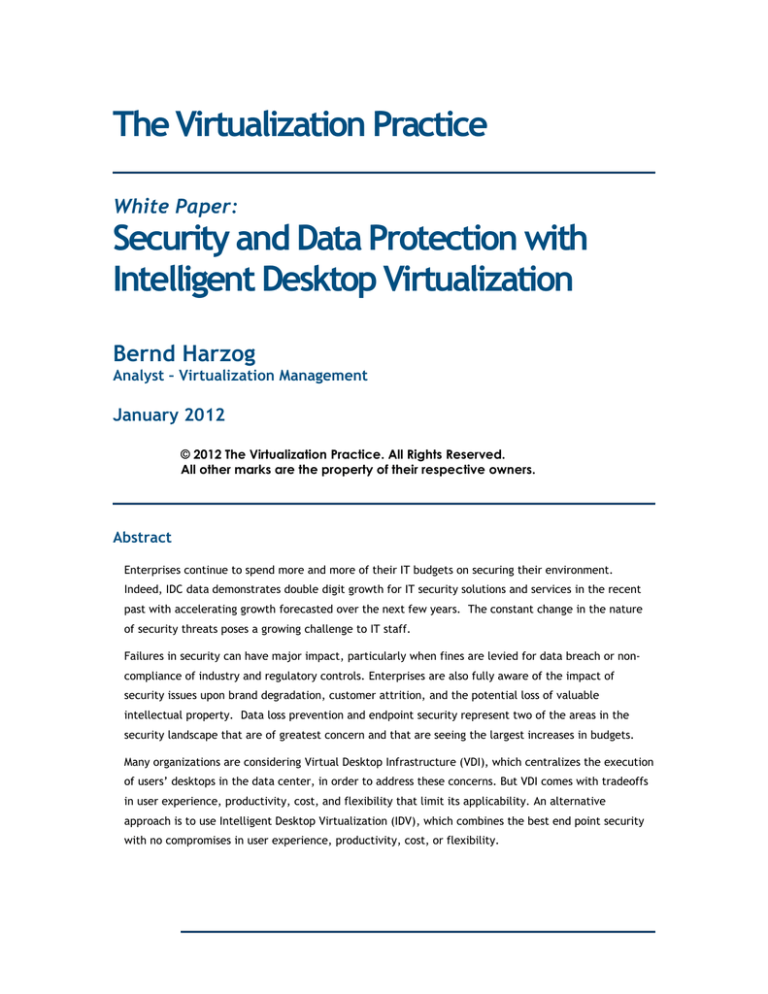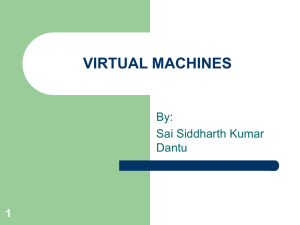
The Virtualization Practice
White Paper:
Security and Data Protection with
Intelligent Desktop Virtualization
Bernd Harzog
Analyst – Virtualization Management
January 2012
© 2012 The Virtualization Practice. All Rights Reserved.
All other marks are the property of their respective owners.
Abstract
Enterprises continue to spend more and more of their IT budgets on securing their environment.
Indeed, IDC data demonstrates double digit growth for IT security solutions and services in the recent
past with accelerating growth forecasted over the next few years. The constant change in the nature
of security threats poses a growing challenge to IT staff.
Failures in security can have major impact, particularly when fines are levied for data breach or noncompliance of industry and regulatory controls. Enterprises are also fully aware of the impact of
security issues upon brand degradation, customer attrition, and the potential loss of valuable
intellectual property. Data loss prevention and endpoint security represent two of the areas in the
security landscape that are of greatest concern and that are seeing the largest increases in budgets.
Many organizations are considering Virtual Desktop Infrastructure (VDI), which centralizes the execution
of users’ desktops in the data center, in order to address these concerns. But VDI comes with tradeoffs
in user experience, productivity, cost, and flexibility that limit its applicability. An alternative
approach is to use Intelligent Desktop Virtualization (IDV), which combines the best end point security
with no compromises in user experience, productivity, cost, or flexibility.
Security and Data Protection with Intelligent Desktop Virtualization
Table of Contents
I.
Introduction ..................................................................................................................... 1
II.
Intelligent Desktop Virtualization (IDV) ....................................................................... 1
III.
Data Is Not Stolen Even If a PC Is ................................................................................ 2
IV.
Lost PC Monitoring, Lockout, & Remote Kill............................................................. 3
V.
Instant Recovery from Malware & Corruptions......................................................... 3
VI.
USB Filtering and Policy Controls............................................................................... 4
VII.
Transparent Backup & Recovery ................................................................................ 3
VIII.
Isolation and Protection of VMs................................................................................... 4
IX.
The Data-Less End-Point Option ................................................................................. 4
X.
Conclusion ....................................................................................................................... 5
XI.
The Virtualization Practice ............................................................................................ 5
XII.
Intel .................................................................................................................................... 6
XIII.
Virtual Computer............................................................................................................. 6
© 2012 The Virtualization Practice, All Rights Reserved.
All other marks are the property of their respective owners.
Security and Data Protection with Intelligent Desktop Virtualization
I. Introduction
The focus on security solutions in the enterprise has been growing steadily over the past few years and is
expected to increase significantly in the next few years. In fact, according to IDC, the worldwide market for
IT security solutions and services is expected to grow at double digit rates — going from $39B in 2011 to over
$62B by 2015. This is driven by several factors, including the rapid growth of end user computing devices
and the increased mobility of those devices. As an example of increased mobility, in the PC market, laptops
have been growing at nearly ten times the rate of desktop computers.
In order to increase end user security, many companies are considering Virtual Desktop Infrastructure, also
known as VDI, which replaces PCs with thin clients and moves both the data and the execution of PC
workloads into the data center. As a result of major marketing investments by VMware and Citrix, VDI has
gained a great deal of attention and interest.
However, VDI suffers from some critical limitations. Users cannot access their computing environment unless
they have a connection to the network. In order for their user experience to be acceptable, that network has
to have sufficient bandwidth and continuously operate with very low end-to-end latency. It must also offer a
high degree of redundancy as employees cannot use their desktops at all during an outage. VDI also comes
with significant costs because major investments are required in servers, storage, and network infrastructure
to support the desktop workloads running on expensive data center resources.
This gives rise to an important question. How does one give end users an environment that provides them
with the best possible user experience and allows IT to meet its mandate to protect corporate data and
endpoint computing assets at the same time — and how does one do this at a reasonable cost? Intelligent
Desktop Virtualization provides organizations a way to achieve this goal.
II.
Intelligent Desktop Virtualization (IDV)
Intelligent Desktop Virtualization (IDV), a phrase coined by Intel, describes an approach to desktop
virtualization that, unlike VDI, offers the best of both worlds — great performance for end users and strong
security and manageability for IT. IDV leverages client-side hypervisor technology to allow enterprise IT to
place a fully managed, backed-up, and secure Virtual Machine (VM) on the end user’s device. IDV also
enables companies to put multiple VMs onto a single PC, so a user can have a Corporate VM and a Personal
VM, each of which works just like a completely isolated, fully functioning PC. IDV delivers the ultimate in
performance to end users because the applications are running locally. Moreover, because IDV uses the
compute power on intelligent clients, it does not require the major infrastructure investment that VDI
requires. In fact, IDV requires less than 1/20th of the infrastructure investment of VDI.
Advanced IDV solutions use technologies such as type-1 client hypervisors to increase isolation and security.
This combined with features like continuous backup ensures that corporate data is always protected and
secure. Moreover, if the end user’s device is lost or stolen, the data on the device can be remotely
destroyed and a new device can be rapidly provisioned, getting the employee productive again quickly.
© 2012 The Virtualization Practice, All Rights Reserved.
All other marks are the property of their respective owners.
Security and Data Protection with Intelligent Desktop Virtualization
How does IDV provide IT with the ability to control and secure desktop images and devices while ensuring
users enjoy high performance, mobility, and flexibility? IDV delivers on this promise by stipulating three
tenets:
1)
Manage centrally and execute locally to minimize data center build-out and leverage the processing
power of an intelligent client to optimize the user experience.
2)
Deliver layered images intelligently to enhance updating and patching, streamline storage, and avoid
image drift. When IT separates the desktop image into its logical layers, it can manage each layer
separately and minimize the number of images. Intelligent delivery requires that the local image
running on the PC be synchronized with the central image. This ensures that end users and IT are
working with a golden image at all times. The synchronization and storage of these images should be
enhanced with de-duplication technology to minimize storage and network bandwidth requirements.
3)
Use device-native management to provide out-of-band (OOB) access to the device to provide
hardened security capabilities and enhanced manageability independent of the OS.
By implementing a solution that adheres to these three principles, IT is able to manage a single central
image and deliver it to the user’s device where it best can be executed with the highest level of security.
III. Data Is Not Stolen Even If a PC Is
IDV solutions use advanced encryption techniques to protect locally stored data. The most advanced IDV
solutions use full disk encryption instead of encrypting just the files containing the virtual machines. Full
disk encryption provides a higher level of security and is also superior for compliance, because certain
regulations requiring encryption specifically mandate full disk encryption. Ensuring that your IDV solution
offers full disk encryption provides organizations with a better way to comply with the broadest set of
current and future regulations.
The most secure IDV solutions also use a type-1 hypervisor on the client. With a type-1 hypervisor, the hard
disk is owned directly by the hypervisor with no underlying operating system intervening. If security and
performance of high importance to organizations, they should make sure to purchase a desktop virtualization
solution with a true type-1 client hypervisor.
One important benefit that IDV solutions provide is that the data on the end user device is not accessible
until the user fully authenticates to unlock the device. If the desktop or laptop is stolen and the hard disk is
removed and put into another computer in attempt to access the data, the encrypted data is not accessible.
Companies are legally required to report lost or stolen data. A critical benefit to using full disk AES-256
encryption is that even if the device is lost, there is no data breach as long as this level of encryption is in
place. In fact, AES-256 full disk encryption is so strong, it’s used to protect the highest level of government
classified top secret information.
© 2012 The Virtualization Practice, All Rights Reserved.
All other marks are the property of their respective owners.
Security and Data Protection with Intelligent Desktop Virtualization
IV. Transparent Backup & Recovery
Corporate data is automatically and continuously backed up. IDV solutions include management features that
automatically detect changes to end user files and transparently and incrementally stream those changes
back to the data center where a backup image of the end user’s environment is kept. This means that if the
end users’ laptop is lost or stolen, the end user’s computing environment and their data is not lost at the
same time. Rather a completely up-to-date replacement image with the most recently backed-up data can
be pushed onto a new laptop. With advanced IDV solutions, IT departments can set policies for which items
are backed up, how often backups are taken, and how many backup versions are stored. They also provide
differential backup and de-duping capabilities to reduce network bandwidth and storage requirements.
V. Lost PC Monitoring, Lockout, & Remote Kill
IDV solutions also offer capabilities to continuously monitor end point devices in order to identify and track
lost or stolen PCs. Policies can be set to require PCs to check into the central management server on a predefined frequency, and if the device fails to check in, the system can be configured so that the virtual
machines become inaccessible. With advanced IDV solutions, monitoring frequencies and lockout policies
can be set for each individual virtual machine, so that a different policy can be used for a Corporate VM
versus for a Personal VM.
In the case where a PC is confirmed to be lost or stolen, IDV solutions can issue a self-destruct command to
the PC. When the PC next connects to the Internet, that command is received by the PC and all of the data,
applications, settings and profiles on that machine are destroyed. The most advanced IDV solutions perform
a 7-pass DOD (Department of Defense) compliant wipe of the entire hard drive. Although the data on the
machines is already encrypted and therefore cannot be accessed without proper authentication, the ability
to lockout VMs and the ability to remotely wipe the hard drive provide additional levels of security.
Note that even if the machine is lost and the drive needs to be wiped, the data will not be lost. This is
because the data would have been automatically backed up by the transparent incremental backup features.
VI. Instant Recovery from Malware & Corruptions
Capabilities such as “snap back” enable PCs to automatically boot from a pristine golden state every time.
So if a virus infects a system, eliminating the virus is as simple as rebooting. This also has the added benefit
of keeping computers running quickly. Traditionally, Windows performance tends to degrade over time,
reducing the performance of PCs. But with advanced IDV solutions, every time a PC boots, it boots from the
clean, golden image ensuring the best performance.
Some IDV solutions also allow IT administrators to setup reboot policies, which can be extremely valuable for
large banks of computers used in training centers, libraries, or other areas where shared use computers are
deployed. In these use cases, traditional PCs rapidly degrade in performance as different users wreak havoc
on the settings, plug-ins, and applications on the PCs. With reboot policies and snap back capabilities, IT
© 2012 The Virtualization Practice, All Rights Reserved.
All other marks are the property of their respective owners.
Security and Data Protection with Intelligent Desktop Virtualization
administrators can set these machines to automatically boot to a pristine state every night (or whatever
schedule is specified) to make management of these machines virtually maintenance free.
VII. USB Filtering and Policy Controls
IDV solutions also give the IT department granular control over USB device permissions. For example, certain
types of devices can be permitted while others are disallowed. And these permissions can be set separately
for each VM assigned to the user. So for example, the Corporate VM can have more restrictive policies than
the Personal VM.
Using these policies, IT departments can set up permissions so that Corporate VMs are prohibited from using
mass storage devices (to prohibit data theft), but are permitted to use devices such as headsets or
microphones for unified communications applications. Meanwhile, they can set up policies to allow all USB
devices on Personal VMs.
VIII. Isolation and Protection of VMs
Since the type-1 client hypervisor in an IDV solution owns all of the hardware resources on the end user
device, including the keyboard and display drivers, viruses which attack the Windows versions of these
drivers with the intent of logging keystrokes or scraping screen data are rendered ineffective. This is another
example of leveraging the hypervisor to provide a level of security functionality to a guest operating system
that is not available natively.
The type-1 hypervisor maintains complete separation between environments (e.g., Corporate and Personal
VMs), making it impossible for “bad behavior” in the personal partition to leak over and affect the corporate
partition. This is one of the best ways to allow users the freedom to do what they want to do in their
personal environments, while keeping the corporate environment locked down and safe, and allow both of
these environments to co-exist on the same PC or laptop.
IX. The Data-Less End-Point Option
There are some use cases where data is not permitted to leave the datacenter under any circumstances —
typically for compliance reasons. Some IDV solutions provide an option to host all of the data and the VMs
centrally while still providing a rich end user experience by running the client hypervisor on the end point
device. In this scenario, organizations can use low cost, fan-less PCs with small flash drives to run the client
hypervisor while storing the VMs and data on a storage array network. In this model, the screen rendering
and graphics are still done locally, providing better end user performance than VDI. And because the local
compute power of the PC is used, the total cost is lower than VDI in this model as well.
© 2012 The Virtualization Practice, All Rights Reserved.
All other marks are the property of their respective owners.
Security and Data Protection with Intelligent Desktop Virtualization
X. Conclusion
In a recent survey by Intel of over 200 IT professionals, security was selected as one of the top reasons for
implementing desktop virtualization:
Source: Intel IT Center Peer Research, Desktop Virtualization Insights for IT Strategic Planning, September 2011
While VDI solutions can enhance security, they cannot deliver an excellent user experience across all types
of applications (including rich media), and across all connectivity scenarios (including low bandwidth
connections, and no available connectivity). They also require massive investments on servers, storage, and
networking in order to deliver even moderate user performance.
IDV delivers both the security and manageability required by IT and the end user experience required by the
end users. It is the only approach to desktop virtualization that does not involve compromising one of
reliability, security or end user experience in order to meet the other goals. Moreover, IDV delivers all of
these capabilities at less than 1/20th of the infrastructure cost of VDI. With IDV, organizations are able to
meet the needs of both IT and end users, while delivering immediate return on investment.
XI. The Virtualization Practice
The Virtualization Practice provides analysis, commentary, and resources on current Virtualization and Cloud
Computing news, events, and community. We break Virtualization into Topics, and feature a world class
expert in that topic as the analyst for the topic. Topic Analysts are responsible for writing original,
objective, analysis in their area of expertise, and for writing and maintaining a white paper on their market
and the vendors that serve that market.
Bernd Harzog
Bernd Harzog is the Analyst at The Virtualization Practice for Virtualization Management. Bernd is also the
CEO and founder of APM Experts, a company that provides strategic marketing services to vendors in the
© 2012 The Virtualization Practice, All Rights Reserved.
All other marks are the property of their respective owners.
Security and Data Protection with Intelligent Desktop Virtualization
virtualization management markets. Prior to these two companies, Bernd was the CEO of RTO Software, the
VP of Products at Netuitive, a General Manager at Xcellenet, and Research Director for Systems Software at
Gartner Group. Bernd has an MBA in Marketing from the University of Chicago.
XII. Intel
Intel is the leader in microprocessor innovation. By introducing Intel® Virtualization Technology (Intel® VT)
to the market, Intel enabled virtualized machines to run at near-native performance levels. Intel continues
to innovate with technologies such as Intel® Core™ vPro™ processors that combine CPUs and graphics
processing. Intel® Core™ vPro™ processors offer greater levels of manageability and security at the hardware
level.
Learn more about Intel® Core™ vPro™ at
www.intel.com/technology/vpro.
XIII. Virtual Computer
Virtual Computer is a market leader in Intelligent Desktop Virtualization, combining client-hosted
virtualization with centralized management. The company’s flagship product, Virtual Computer NxTop®,
makes managing thousands of desktops and laptops as easy as managing one, while offering new levels of
flexibility and productivity to end users. NxTop delivers ultra-fast native PC performance, complete mobility,
and better manageability than server-hosted VDI for a fraction of the cost.
Get a free download of NxTop at
www.virtualcomputer.com.
© 2012 The Virtualization Practice, All Rights Reserved.
All other marks are the property of their respective owners.


